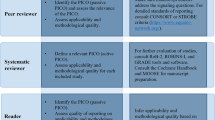Abstract
Background: Although the word evidence-based medicine (EBM) has gained wide popularity, only a few studies have evaluated how EBM works in clinical practice. Methods: We have prospectively evaluated the feasibility of evidence-based trauma surgery. Orthopaedic trauma surgeons were asked to produce clinical questions related to the treatment of current patients. An informaticist searched the literature (Medline, Cochrane Library, practice guidelines and textbooks) and reported the findings on every following day. The study’s main endpoints were the rate of questions for which relevant evidence (>level V) was available and the time necessary to find and critically appraise medical evidence. Results: In total, 44 EBM questions were formulated, mainly concerning treatment options. PubMed was searched for 39 questions, textbooks for 14, the Cochrane Library for 11, online guidelines for 9 and other sources were used for 4 questions. On average, 157 text items (three per questions) were identified as potentially relevant. Journal articles predominated (83%) over textbooks (10%). Sixty-eight percent of the questions (30 of 44) were answered, either on the basis level 1 (n=13 questions), level 2 (n=6), or level 4 evidence (n=14). Trying to answer a question required 53 min on average, split up between 39 min of database searches and 25 min of obtaining full text articles. In four cases, the evidence suggested a change in clinical management. The physicians were very appreciative of our project and found the provided evidence very helpful for their clinical decisions. Conclusions: Time will be the main barrier against the introduction of clinical EBM. It is likely that clinicians reduce EBM to those situations where evidence is likely to be found. Although the impact of EBM on patient-care was limited, the concept of EBM was successfully implemented.
Similar content being viewed by others
References
Bazarian JJ, Davis CO, Spillane LL, Blumstein H, Schneider SM (1999) Teaching emergency medicine residents evidence-based critical appraisal skills: a controlled trial. Ann Emerg Med 34:148–154
Del Mar CB, Silagy CA, Glasziou PP, Weller D, Spinks AB, Bernath V, Anderson JN, Hilton DJ, Sanders SL (2001) Feasibility of an evidence-based literature search service for general practitioners. Med J Aust 175:134–137
Euler U, Juche A, Brüggenjürgen B, Kunz R, Willich SN (2002) Implementierung evidenzbasierter Medizin in der klinischen Praxis–Angebot einer externen Recherche mit kritischer Bewertung der Literatur. Z Ärztl Fortbild Qualitätssich 96:325–331
Fabian TC (1999) Evidence-based medicine in trauma care: whither goest thou? J Trauma 47:225–232
Greenhalgh T, Hughes J, Humphrey C, Rogers S, Swinglehurst D, Martin P (2002) A comparative case study of two models of a clinical informaticist service. BMJ 324:524–529
Hanson BP, Bhandari M, Audige L, Helfet D (2004) The need for education in evidence-based orthopedics: an international survey of AO course participants. Acta Orthop Scand 75:328–332
Hooker RC (1997) The rise and rise of evidence-based medicine [letter]. Lancet 349:1329–1330
Howes N, Chagla L, Thorpe M, McCulloch P (1997) Surgical practice is evidence based. Br J Surg 84:1220–1223
Hurwitz SR, Slawson D, Shaughnessy A (2000) Orthopaedic information mastery: applying evidence-based information tools to improve patient outcomes while saving orthopaedists’ time. J Bone Joint Surg 82-A:888–894
Kingston R, Barry M, Tierney S, Drumm J, Grace P (2001) Treatment of surgical patients is evidence-based. Eur J Surg 167:324–330
Langdorf MI, Koenig KL, Brault A, Bradman S, Bearie BJ (1995) Computerized literature search in the ED: patient care impact [letter]. Acad Emerg Med 2:157–159
Lindberg DAB, Siegel ER, Rapp BA, Wallingford KT, Wilson SR (1993) Use of MEDLINE by physicians for clinical problem solving. JAMA 269:3124–3129
MacRae HM, Regehr G, McKenzie M, Henteleff H, Taylor M, Barkun J, Fitzgerald GW, Hill A, Richard C, Webber EM, McLeod RS (2004) Teaching practicing surgeons critical appraisal skills with an Internet-based journal club: a randomized, controlled trial. Surgery 136:641–646
Michaud GC, McGowan JL, van der Jagt RH, Dugan AK, Tugwell P (1996) The introduction of evidence-based medicine as a component of daily practice. Bull Med Libr Assoc 84:478–481
Reilly B, Lemon M (1997) Evidence-based morning report: a popular new format in a large teaching hospital. Am J Med 103:419–426
Sackett DL, Straus SE (1998) Finding and applying evidence during clinical rounds: the “evidence cart”. JAMA 280:1336–1338
Sackett DL, Rosenberg WM, Muir Gray JA, Haynes RB, Richardson WS (1996) Evidence based medicine: what it is and what it isn’t. BMJ 312:71–72
Sauerland S, Lefering R, Neugebauer EAM (1999) The pros and cons of evidence-based surgery. Langenbeck’s Arch Surg 384:423–431
Sauerland S, Bouillon B, Neugebauer E (2003) Praktische Anwendung der EBM in der Chirurgie: Evidenz und Erfahrung. Z Ärztl Fortbild Qualitätssich 97:271–276
Scura G, Davidoff F (1981) Case-related use of the medical literature. JAMA 245:50–52
Spillane AJ, Crowe PJ (1998) The role of the journal club in surgical training. Aust N Z J Surg 68:288–291
Swinglehurst DA, Pierce M, Fuller JCA (2001) A clinical informaticist to support primary care decision making. Qual Health Care 10:245–249
Toedter LJ, Thompson LL, Rohatgi C (2004) Training surgeons to do evidence-based surgery: a collaborative approach. J Am Coll Surg 199:293–299
Ubbink DT, Legemate DA (2004) Evidence-based surgery. Br J Surg 91:1091–1092
Young JM, Hollands MJ, Ward J, Holman CDJ (2003) Role for opinion leaders in promoting evidence-based surgery. Arch Surg 138:785–791
Author information
Authors and Affiliations
Corresponding author
Rights and permissions
About this article
Cite this article
Krahn, J., Sauerland, S., Rixen, D. et al. Applying evidence-based surgery in daily clinical routine: a feasibility study. Arch Orthop Trauma Surg 126, 88–92 (2006). https://doi.org/10.1007/s00402-005-0095-0
Received:
Published:
Issue Date:
DOI: https://doi.org/10.1007/s00402-005-0095-0




